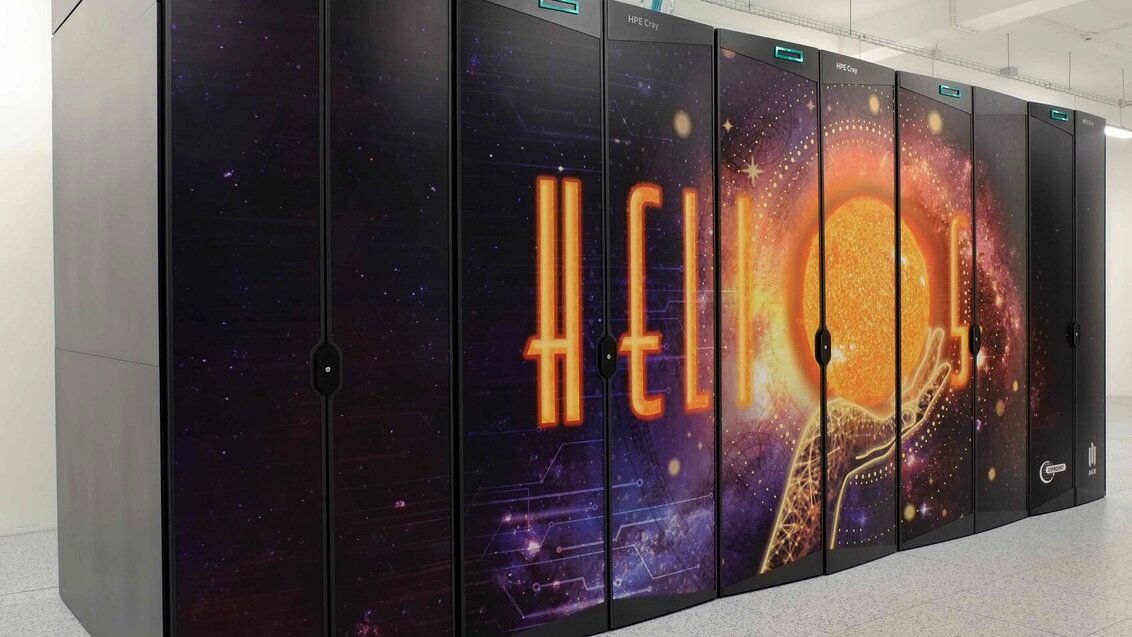At the international ISC High Performance 2024 conference held on 12-16 May in Hamburg, new TOP500 and Green500 lists of the most powerful supercomputers in the world have been announced. The fastest computational machine in Poland is now Helios from the AGH University Academic Computer Centre CYFRONET. For the first time in the history of Polish computer science, as many as 4 supercomputers from a single centre, the Academic Computer Centre CYFRONET, are included on the prestigious TOP500 list. Moreover, Helios ranks 3rd on the Green500, namely the list of the most energy-efficient supercomputers. Thus far, none of the Polish systems have reached so high.
Supercomputers enable the performance of computations which would normally take plenty of years on individual computers in a matter of a few hours or days. Helios is going to carry out a few hundred research projects a year for researchers all around Poland in the fields of chemistry, physics, materials engineering, energy engineering, medicine, biology, and AI. It was built as part of a project implemented within the Smart Growth Operational Programme. Its computational power may also be used commercially by the economy.
Since 2021, the AGH University Academic Computer Centre CYFRONET has been the leader of the National Competence Centre in HPC as part of the international project EuroHPC aimed at fostering competence in computing, AI, and facilitating access to computing resources for research entities, public administration, and businesses, with particular focus on small and medium-sized enterprises (SMEs) and start-ups. One mechanism to support SMEs are short Proof-of-Concept projects, which will be carried out with the use of Helios and are expected to demonstrate the potential of supercomputing in business.
Helios has 35 PFLOPS of theoretical computing power, over 108 thousand computational cores, 460TB of RAM, and 18PB of disk system capacity, which altogether offer a performance of almost 2TB/s. Its installation finished in December 2023 as a result of a project for the development of a national supercomputing ecosystem, EuroHPC PL, coordinated by CYFRONET. The supercomputer was built according to CYFRONET's design by Hewlett-Packard Enterprise based on the HPE Cray EX4000 platform and consists of three computing partitions:
- CPU with 75,264 AMD Zen4 computational cores and 200TB DDR5 working memory,
- GPU equipped with 440 NVIDIA Grace Hopper GH200 superchips,
- INT for interactive work, equipped with 24 NVIDIA H100 accelerators and a fast local memory NVMe.
All components of the supercomputer are interconnected by a 200 GB/s Slingshot network. The HPE Cray EX4000 platform, based on which Helios is built, is also used in the fastest supercomputers in the world (Frontier) and in Europe (LUMI). With direct liquid cooling of the CPU and GPU partitions, it is possible for the system to achieve a very low PUE (Power Usage Effectiveness), resulting in increased energy efficiency and lower operating costs. The additional heat obtained this way may be used for heating.
Helios debuted on the TOP500 in November 2023, when its CPU partition took the 291st place with its initial efficiency result. It holds two posts on the current edition of the list. The GPU partition of Helios ranks 55th, whereas the CPU partition - 305th. The division into two separate entries results from the desire to showcase full capabilities of each computing partition with the use of specially optimised versions of benchmarks, created in collaboration between CYFRONET’s experts and HPE, NVIDIA, and AMD. Helios' computing power is equivalent to the speed of around 50,000 modern laptops or the computing power of a pretty big city.
A great success in our portfolio is Helios’ GPU energy efficiency result, ranking it third on the Green500 list. At the same time, it is worth noticing that the systems from Germany and the Great Britain preceding the Polish supercomputer are much smaller. Thus, Helios is the most energy-efficient supercomputer out of the first 100 in the TOP500 list. Currently, energy efficiency is one of the most significant metrics used for the evaluation of new supercomputers, as it directly influences the exploitation costs of machines which require an enormous amount of electric power. As regards the fastest supercomputers in the world, the amount is even 30 MW, which translates into immense yearly electricity costs. Energy efficiency at such a high level means that Helios has at its disposal more computational power for each consumed kWh than less effective systems, therefore its computations are not only more economical than those of other similar machines, but they have less of an environmental impact.
The current TOP500 list includes eight supercomputers from Poland (theoretical computational power on brackets):
# 55 – Helios GPU (30,44 PFLOPS) – AGH University CYFRONET,
# 76 – Proxima (23,32 PFLOPS) – PCSS at the Polish Academy of Sciences,
# 80 – Lem (20,37 PFLOPS) – Wroclaw Centre for Networking and Supercomputing,
# 154 – Kraken-Fregata (10,02 PFLOPS) – CI TASK, Gdansk University of Technology,
# 177 – Athena (7,71 PFLOPS) – AGH University CYFRONET,
# 250 – Altair (5,88 PFLOPS) – PCSS at the Polish Academy of Sciences,
# 305 – Helios CPU (3,35 PFLOPS) – AGH University CYFRONET,
# 444 – Ares (3,51 PFLOPS) – AGH University CYFRONET.
The access to most of the supercomputers on the above list, as well as to the most powerful supercomputer in Europe, is provided by means of the PLGrid infrastructure.
More information:

 Projects by AGH University Main Library with funding from Scientific Social Responsibility programme
Projects by AGH University Main Library with funding from Scientific Social Responsibility programme  On energy transformation and more. Distributed Energy Congress
On energy transformation and more. Distributed Energy Congress  Polish natural hydrogen initiative. AGH University concludes an agreement
Polish natural hydrogen initiative. AGH University concludes an agreement  Honouring those we lost this year
Honouring those we lost this year  AGH Solar Boat the best in Sardinian competition
AGH Solar Boat the best in Sardinian competition  AGH University Alumni Day 2024
AGH University Alumni Day 2024  AGH University to establish AI Factory
AGH University to establish AI Factory 

